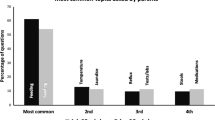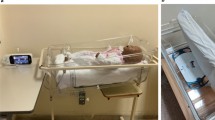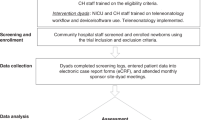Abstract
OBJECTIVE:
To evaluate the effect of weekly telephone contact with families in enhancing the use of home apnea monitors.
STUDY DESIGN:
This was a prospective, randomized, single-blinded study of 65 infants who were prescribed home apnea monitoring at the time of initial discharge from the hospital. Exclusion criteria included participation in any other study involving home monitoring or nonavailability of home telephone. Infants were randomized either to the “standard” or “telephone” group by a stratified balanced block technique. All families were instructed to use the monitor during the first 4-week period at all times except during bathing and during the second 4-week period at all unattended times and at night. The families in the telephone group were contacted weekly for 8 weeks. The telephone interview reviewed the events of the previous week but did not include specific encouragement to use the monitor. Both groups received routine pediatric care and follow-up at our high-risk premature clinic. The primary outcome measure was compliance measured as the percentage of time as well as the hours per day that the infant spent on the monitor as recorded by the documented monitor.
RESULTS:
The telephone (n = 30) and standard (n = 32) groups were similar (p > 0.10) with respect to birth weight (1567 ± 778 versus 1710 ± 777 gm), gestational age (30.9 ± 4.2 versus 31.1 ± 4.6 weeks), maternal age (24.9 ± 6.0 versus 25.3 ± 5.4 years), and commercial insurance (46.7% versus 46.9%), a marker of higher socioeconomic status. Compliance of the telephone versus the standard group was similar during thefirst 4-week period (74.7 ± 24.9 versus 75 ± 27.8%, p = 0.85) (17.9 ± 5.9 versus 18.2 ± 6.6 hours/day), the second 4 week period (63.4 ± 29.1 versus 58.9 ± 30.9%, p = 0.59) (15.2 ± 7.0 versus 14.1 ± 7.4 hours/day) and the entire 8-week period (69.3 ± 24.7 versus 67.7 ± 26.2%, p = 0.82, Mann-Whitney U-test) (16.7 ± 6.0 versus 16.1 ± 6.5 hours/day), respectively. An abnormal pneumocardiogram at the time of discharge was the only identified factor that improved the compliance for the entire 8-week period (73.1 ± 22 versus 52.1 ± 28.5%, p = 0.02) (17.5 ± 5.2 versus 12.5 ± 6.8 hours/day) and the first 4-week period of monitoring (81.7 ± 22.9 versus 59.5 ± 31.3%, p = 0.01) (19.6 ± 5.5 versus 14.2 ± 7.5 hours/day).
CONCLUSION: Weekly telephone contact, without specific encouragement to use the monitor, did not improve compliance. Compliance was greater in subjects who had abnormal pneumocardiogram results at the time of discharge from hospital regardless of their telephone/standard group assignment. We speculate that in this already compliant population, more targeted advice is necessary to increase compliance.
This is a preview of subscription content, access via your institution
Access options
Subscribe to this journal
Receive 12 print issues and online access
$259.00 per year
only $21.58 per issue
Buy this article
- Purchase on Springer Link
- Instant access to full article PDF
Prices may be subject to local taxes which are calculated during checkout
Similar content being viewed by others
Author information
Authors and Affiliations
Additional information
This study was funded in part by grant M01RR00080 from Ameritech andGeneral Clinical Research Center.
Rights and permissions
About this article
Cite this article
Mohan, C., Baird, T., Super, D. et al. Weekly Telephone Contact Does Not Enhance the Compliance of Home Apnea Monitoring. J Perinatol 19, 505–509 (1999). https://doi.org/10.1038/sj.jp.7200261
Published:
Issue Date:
DOI: https://doi.org/10.1038/sj.jp.7200261



